IN THIS ISSUE
- How to rescue a manatee
- Invasion of the snakeheads
- Drought impacts on wildlife
- Hellbenders' deadly neighbors
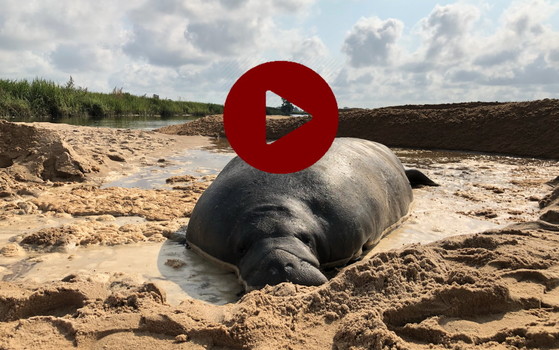 Grounded in Savannah (Continental Heavy Civil Corp.); video by Joe Malo (Clearwater Marine Aquarium)
Rescuing a big manatee stuck on dry ground can be a doozy.
Which is why it helps to have a dozer.
Responding to a call on Oct. 1, Georgia DNR and Clearwater Marine Aquarium Research Institute found an adult female manatee stranded on a sandy berm across Rifle Cut near Savannah.
Manatees, protected marine mammals, once used the manmade waterway to swim between the Middle and Little Back rivers. But the U.S. Army Corps of Engineers is filling in Rifle Cut to create wetlands and enhance river flows.
Continental Heavy Civil Corp., the corps’ contractor, found the grounded manatee that morning. The 10-foot-long animal apparently tried to swim from the Little Back River into Rifle Cut during high tide, became stuck and was left high and dry when the tide fell. Continental’s crew kept the manatee wet until responders arrived.
In consultation with the U.S. Fish and Wildlife Service, DNR Wildlife Conservation Section and Clearwater Marine Aquarium Research Institute staff checked the manatee’s health and fitted her with a satellite transmitter. Then they tackled the obvious challenge: How to move her to the water?
The answer in this case: Bring the water to her.
A Continental employee used a bulldozer to dig a shallow channel to the river. As water surged in, the manatee was eased onto a stretcher and hauled to deeper water, where she was released unharmed (watch).
The satellite transmitter shows that the manatee has stayed in the area. Biologists hope she begins moving south soon, both to reach warmer water in Florida for winter and to avoid vessel traffic in Savannah’s busy port. Since Sept. 11, three manatees have been found dead in the Savannah River from large propeller strikes.
All work involved in the rescue was done under Fish and Wildlife Service permits MA770191 and MA37808A.
Top
 Snakeheads caught in Gwinnett County (special to DNR)
The news flash sounds like a schlock horror movie:
Fish with snake-like heads, sharp teeth, big appetites and the ability to breathe air and even, as juveniles, wriggle across land are invading Georgia.
Fake news? Nope.
Northern snakeheads turned up in Gwinnett County this month. An angler landed two in a private pond. DNR then netted two adults and 14 juveniles in the pond and a wetland that drains into the Yellow River. Although the eastern Asia species has been found in 14 other states, this is a first for Georgia.
Why the worry? Non-native species can compete with native fishes for food and habitat. Snakeheads are voracious feeders. They grow up to 3 feet long. And they multiply fast.
DNR’s Fisheries Management Section is working to assess and control them in Gwinnett. But help from the public, and especially anglers, is crucial.
Fisheries Chief Matt Thomas said anglers are the “first line of defense … against aquatic invasive species.”
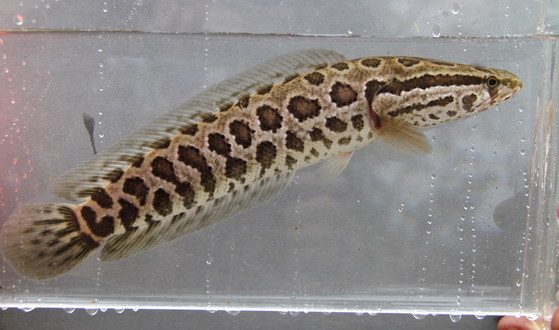 Juvenile snakehead caught by DNR in Gwinnett (DNR)
WHAT YOU CAN DO
- Learn how to identify northern snakeheads.
- Dispose of aquarium animals and plants in the garbage, not in waterways. Invasive species are often introduced through unauthorized release. In Georgia, it is illegal to import, transport, sell, transfer or possess any species of snakehead fish without a wild animal permit.
- Dispose of bait in trash cans, at disposal stations or above the waterline on dry land. Dump water from boat compartments, bait buckets and live wells on dry land.
If you think you have caught a northern snakehead, kill it immediately (remember, it can survive on land) and freeze the carcass. If possible, take pictures, including close-ups of the mouth, fins and tail. Record where it was caught (waterbody, landmarks or GPS coordinates), and report it to a regional DNR office
Bowfins, a native fish, are often misidentified as snakeheads. Here's a helpful fact sheet (also click the graphic below). Learn more about aquatic invaders.
 Graphic: Arkansas Game and Fish Commission
Top
 Drought saps food sources such as goldenrod, a key plant for pollinators in fall. (Terry W. Johnson)
By TERRY W. JOHNSON
Most of Georgia has suffered from a combination of high temperatures and drought this summer.
For example, only a 10th of an inch of rain fell at my home in middle Georgia in September. In spite of two recent rains, as I write this column, the rainfall totals in Macon are still some 9 inches below normal.
In addition, daily temperatures in late summer powered heat indexes topping 100.
While these conditions had a negative impact on all of us, the impact on wild plant and animal communities has been potentially far worse. And those effects could continue well beyond 2019.
With that in mind, let's look at how drought can stress the natural world. ...
Read Terry’s column about the drought fallout and how you can help wildlife.
Terry W. Johnson is a retired DNR program manager and executive director of TERN, the Wildlife Conservation Section’s friends group. Read past columns, his Backyard Wildlife Connection blog and his book “A Journey of Discovery: Monroe County Outdoors.” (Permission is required to reprint this column.)
Top
 Hellbender in north Georgia (Thomas Floyd/DNR)
Eastern hellbenders are besieged by manmade threats such as excessive silt and warming waters in the mountain streams they inhabit. But it’s easy to forget these big salamanders also face natural dangers.
Angler Austin Taylor was trout fishing on the Chattahoochee National Forest in north Georgia this summer when he videoed a large northern watersnake attacking an adult hellbender (watch).
Although he fishes the area often, “this is the first time I have seen something like that,” Taylor said.
DNR wildlife biologist Thomas Floyd, who leads the agency’s hellbender research, said the interaction isn’t unusual, but seeing it is. The DNR Stream Team has documented a watersnake tangling with a hellbender. Photographer David Herasimtschuk was named a Wildlife Photographer of the Year winner for this shot of a hellbender grabbing a watersnake in Tennessee’s Tellico River.
“When it comes to interactions between these species,” Floyd said, “which is predator and which is prey is largely determined by size.”
Which brings us to North American river otters. These fast swimmers can top 5 feet long and 30 pounds. They also are thriving, including in north Georgia, where their numbers were once diminished. Translation: They have the size advantage.
Last month, Floyd caught an 11-inch-long male hellbender on the Toccoa River that had been bitten, possibly by an otter. He has also found dead ones bearing teeth marks, skeletons and even hellbender skulls left on rocks in streams, evidence that likely points to otters, which are known to prey on hellbenders.
Floyd hopes the Toccoa hellbender fares better. Using a suture kit designed for humans, he stitched up the bite wound, then tagged and released the hellbender.
“If he lives, I could potentially catch him again and see how he’s doing.”
If so, the hellbender will have run a gauntlet of risks, some posed by his wild neighbors.
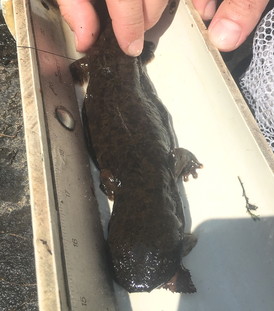
HELLBENDERS AT A GLANCE
-
North America’s largest salamander. Grows up to 29 inches long.
- Found in clear, cool, fast-flowing mountain streams from southern New York to north Georgia.
- Feeds mainly on crayfish. Also eats fish, snails, frogs, snakes and small mammals.
- Common names include mud devil, devil dog, snot otter and lasagna lizard.
- Fully aquatic; breathes primarily through its skin. Considered a bell-weather of water quality.
- Primary threat is degradation of stream habitat, such as from siltation, pollution and dams.
- State-listed as threatened in Georgia. Federal listing determined not warranted this year.
Follow DNR Wildlife Resources Division’s Creepy Critters Week, including hellbenders, on Instagram and Facebook.
Top
|
 UGA's Miranda Gulsby and DNR's Matt Elliott with a young tortoise at Sansavilla (Justin Eckelberry/Zoo Atlanta)
The gopher tortoise population at Sansavilla Wildlife Management Area is growing. Thirty-one juvenile tortoises raised by UGA Odum School of Ecology researchers were recently released into hand-dug burrows at the Wayne County WMA in partnership with DNR and Southern Ionics Minerals.
What do you call a group of tortoises? The online consensus is “creep” – as in "a creep of tortoises" – while other sources, including Country Music Hall of Fame’s Grandpa Jones, favor “herd.”
River Creek not only had its first red-cockaded woodpecker fledgling this year, the wildlife management area near Thomasville welcomed five more of the endangered woodpeckers from Apalachicola National Forest this month. The translocations are aimed at helping reestablish the species at River Creek ("Rare birds return," Nov. 3, 2017).
A Georgia Plant Conservation Alliance workday at Gordonia-Alatamaha State Park focused on mapping and counting sweet pitcherplants in a bog at the Reidsville park. The work will help determine next steps for managing the bog, the only protected site for sweet pitcherplants in southeast Georgia.
Bats are being celebrated around the globe as part of Bat Week, which runs through Oct. 31. The goal: raise awareness about conserving bats and how important these flying mammals are to nature and people. (And what bat campaign would be complete without a photo of hammer-headed bats?)
Top
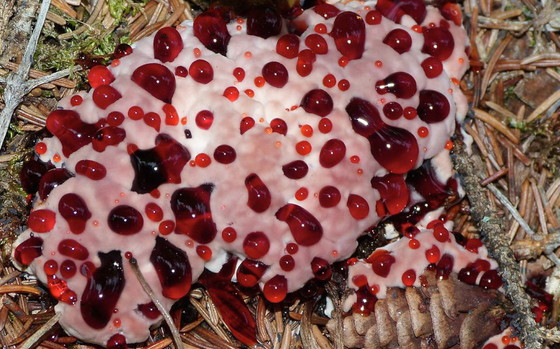 Bleeding tooth fungus (J. Mills/NPS)
Ever heard a barn owl call or seen a bleeding tooth fungus? Thrill to the barn owl’s “scream” on the DNR Wildlife Resources Division Facebook page, and learn about the native fungus that looks like a double for the blob on the agency’s blog.
Also in keeping with the season, Leaf Watch 2019 is on. For full-color highlights, keep tabs through DNR State Parks and Historic Sites and the Georgia Forestry Commission, with trip tips also available at exploregeorgia.org.
When wandering the woods, remember that firearms season for deer opened statewide Oct. 19 and runs through Jan. 12. And if you're wondering about the headgear bucks are sporting this time of year, read this DNR blog post.
Sign up now for DNR’s Youth Christmas Bird Count at Charlie Elliott Wildlife Center near Mansfield, less than an hour’s drive from downtown Atlanta. The Dec. 14 count is free to kids and includes lunch and a wildlife program.
The campground at Charlie Elliott Wildlife Center and Clybel Wildlife Management Area is now fee-based. With online registration in the works, for now contact the center at (770) 784-3059 to reserve one of the 16 campsites.
The 2019 Right Whale Festival is set for Nov. 2-3 at Fernandina Beach, Fla. This free event, timed to the seasonal return of North Atlantic right whales off the Georgia/northeast Florida coast, includes activities, music and a chance to quiz scientists about their work to help keep these imperiled whales from going extinct.
Top
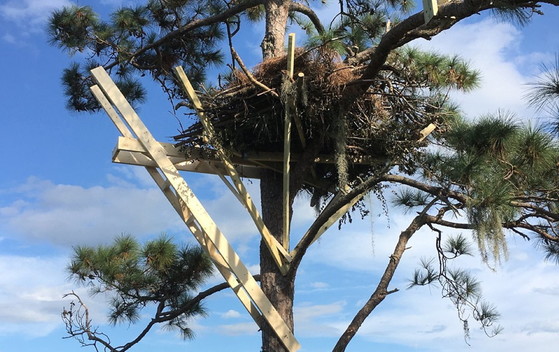 Savannah bird cam nest under construction (The Landings)
Two top bird cams – the Berry College eagles and ospreys-and-owls at The Landings near Savannah – have been overhauled for the upcoming nest seasons. At The Landings, volunteers even built a replacement nest because the current one is in a dead pine that will be cut down.
The southern hognose snake will not be listed under the Endangered Species Act, according to the U.S. Fish and Wildlife. The decision, which notes that while the snake’s range has been limited populations are still found across much of it, will not affect conservation in Georgia, where the southern hognose is listed as a State Wildlife Action Plan high-priority species.
Georgia Sea Turtle Cooperative members found 3,945 loggerhead nests this year, more than double the annual 1,440 nests average since comprehensive surveys began in 1989. Although about 15 percent of nests were lost to tidal inundation from Hurricane Dorian, hatch success measured a relatively high 62 percent ("Nesting weathers storm," September).
Monarch programs at metro Atlanta state parks taught visitors about these beautiful but declining long-distance migrants. Outreach at Panola Mountain near Stockbridge and Sweetwater Creek near Lithia Springs explained the species’ plight and how people can provide habitat by planting native milkweed. Download copies of the Monarchs Across Georgia coloring book at www.georgiawildlife.com.
Georgia boaters who have completed boater education now can show it on their driver’s license or ID card. The change by DNR and the Department of Driver Services adds an anchor logo on the license or ID card, freeing the boater from also having to carry a boating safety ed card when on the water.
Top
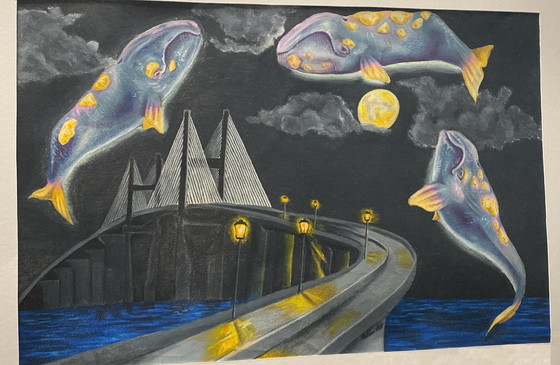 CoastFest Endangered Species Artwork winner
Names in the news: Dream-like imagery of North Atlantic right whales and the Sydney Lanier Bridge by Glynn Academy’s Lillian Stubbs won the Endangered Species Artwork award at CoastFest this month. Stubbs is a senior at the Brunswick school. The Georgia Conservancy announced former President Jimmy Carter as its 2019 Distinguished Conservationist. According to the conservancy, the former president, a charter member of the organization, had a “profound and lasting impact on the conservation and protection of Georgia’s natural resources.” Brian and Becky Tankersley of Double Branches Farm and Produce Market received the 2019 U.S. Farmer-Rancher Pollinator Conservation Award from the North American Pollinator Protection Campaign. The Tankersleys’ fruit and produce farm near Augusta doubles as an outdoor classroom informing visitors about pollinator-friendly practices. As part of DNR's work with foresters and loggers, staff members Steve Raper and Ani Popp explained Georgia's State Wildlife Action Plan and management practices that help conserve aquatic species at a Southeastern Wood Producers education event in Rome, and Todd Schneider discussed rare species at a training session organized by timber products company Norbord. The Georgia Sustainable Forestry Initiative Committee, on which Raper serves, landed the initiative's Implementation Committee Achievement Award this year. The committee was lauded for leadership in logger training, water quality and outreach to landowners, educators and lawmakers. Atlanta Audubon has named Jared Teutsch as its executive director. Teutsch previously worked as conservation director for The Nature Conservancy in Georgia.
UPCOMING
Nov. 1-3 – Becoming an Outdoors Woman workshop, Charlie Elliott Wildlife Center, Mansfield
Nov. 2-3 – Right Whale Fest, Main Beach, Fernandina Beach, Fla.
Nov. 9 – DNR Hunt and Learn on quail, Falling Feathers at Whitaker Farm, Harlem. Also: Nov. 12-14, deer Hunt and Learn, Clybel WMA, Mansfield.
Dec. 14 – Youth Christmas Bird Count, 8:30 a.m.-3 p.m., Charlie Elliott Wildlife Center, Mansfield. Free for kids. Limit: 40 youth. Register: (770) 784-3059.
March 2-6 – Southeastern Partners in Plant Conservation symposium and workshop, Southeastern Center for Conservation, Atlanta Botanical Garden
For more: DNR Wildlife Resources Division events calendar.
WHAT YOU MISSED ...
In the previous Georgia Wild:
- Spot a tegu, tell DNR
- Meet ABAC's Dr. Lane
- Bluebird migration mystery
- 105-pound alligator snapper
Top
"Forecast for a warming world: learning to live with fire," The New York Times
(+video) "Snakehead fish may be invading Georgia," WSB-TV (Ch. 2, Atlanta). Also: The Atlanta Journal-Constitution, USA Today, MSN and others.
"Endangered right whales inch closer to extinction," (Wilmington, N.C.) Star News
"Huge lizards from South America in Georgia," The (Macon) Telegraph. Also: Buckmasters, Augusta Chronicle
"Nest cam site at The Landings gets new nest," Savannah Morning News
"Golden Ray's dismantling still in planning stages," The Brunswick News
"It’s illegal to kill most snakes in Georgia," The Atlanta Journal-Constitution
"Scientists link 21 beached pilot whales dead in Georgia, S.C.," Associated Press
(+audio) "Sharks could get greater protections in Georgia," Georgia Public Broadcasting
"Wildlife Photographer of Year winners showcase stunning scenes," CNN
Top
 VIDEOS
"Deer rescued from 40-foot retention basin," DNR
"Invasive fish found in Gwinnett," WGCL-TV (Ch. 45, Atlanta)
"Creepy critters week: barn owl," DNR
Top
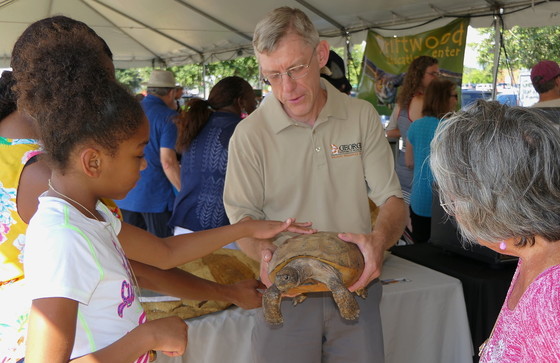 Wildlife Conservation Section technician Matthew Stoddard talks gopher tortoises with some of the more than 12,500 people who attended the 2019 CoastFest in Brunswick. The record crowd at the free educational event enjoyed more than 60 exhibitors, activities such as fishing and rock climbing, and live wildlife varying from barred owls to box turtles. More online.
CREDITS
Masthead: northern snakehead (USFWS)
Hellbender in measuring tray (Thomas Floyd/DNR)
Gopher tortoise outreach at CoastFest (Linda May/DNR)
Top
|